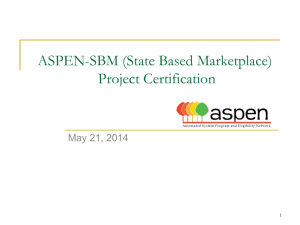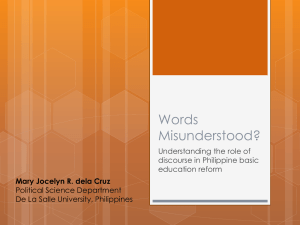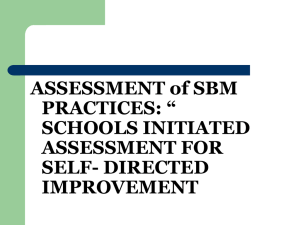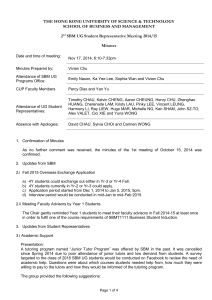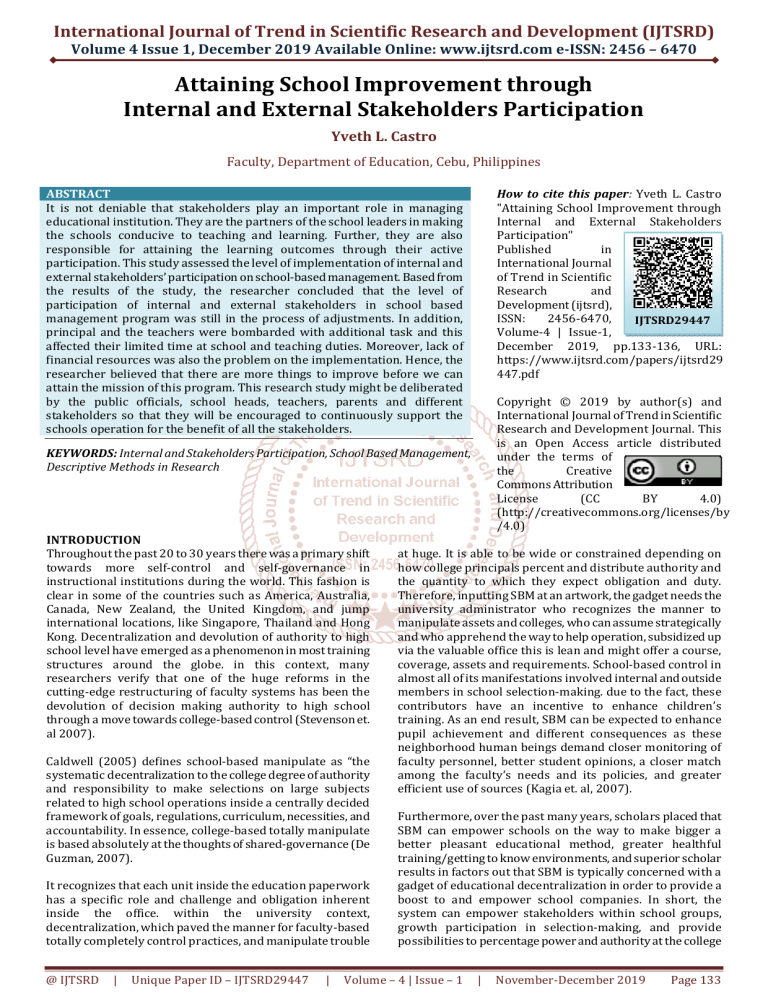
International Journal of Trend in Scientific Research and Development (IJTSRD)
Volume 4 Issue 1, December 2019 Available Online: www.ijtsrd.com e-ISSN: 2456 – 6470
Attaining School Improvement through
Internal and External Stakeholders Participation
Yveth L. Castro
Faculty, Department of Education, Cebu, Philippines
How to cite this paper: Yveth L. Castro
"Attaining School Improvement through
Internal and External Stakeholders
Participation"
Published
in
International Journal
of Trend in Scientific
Research
and
Development (ijtsrd),
ISSN:
2456-6470,
IJTSRD29447
Volume-4 | Issue-1,
December 2019, pp.133-136, URL:
https://www.ijtsrd.com/papers/ijtsrd29
447.pdf
ABSTRACT
It is not deniable that stakeholders play an important role in managing
educational institution. They are the partners of the school leaders in making
the schools conducive to teaching and learning. Further, they are also
responsible for attaining the learning outcomes through their active
participation. This study assessed the level of implementation of internal and
external stakeholders’ participation on school-based management. Based from
the results of the study, the researcher concluded that the level of
participation of internal and external stakeholders in school based
management program was still in the process of adjustments. In addition,
principal and the teachers were bombarded with additional task and this
affected their limited time at school and teaching duties. Moreover, lack of
financial resources was also the problem on the implementation. Hence, the
researcher believed that there are more things to improve before we can
attain the mission of this program. This research study might be deliberated
by the public officials, school heads, teachers, parents and different
stakeholders so that they will be encouraged to continuously support the
schools operation for the benefit of all the stakeholders.
Copyright © 2019 by author(s) and
International Journal of Trend in Scientific
Research and Development Journal. This
is an Open Access article distributed
under the terms of
the
Creative
Commons Attribution
License
(CC
BY
4.0)
(http://creativecommons.org/licenses/by
/4.0)
KEYWORDS: Internal and Stakeholders Participation, School Based Management,
Descriptive Methods in Research
INTRODUCTION
Throughout the past 20 to 30 years there was a primary shift
towards more self-control and self-governance in
instructional institutions during the world. This fashion is
clear in some of the countries such as America, Australia,
Canada, New Zealand, the United Kingdom, and jump
international locations, like Singapore, Thailand and Hong
Kong. Decentralization and devolution of authority to high
school level have emerged as a phenomenon in most training
structures around the globe. in this context, many
researchers verify that one of the huge reforms in the
cutting-edge restructuring of faculty systems has been the
devolution of decision making authority to high school
through a move towards college-based control (Stevenson et.
al 2007).
Caldwell (2005) defines school-based manipulate as “the
systematic decentralization to the college degree of authority
and responsibility to make selections on large subjects
related to high school operations inside a centrally decided
framework of goals, regulations, curriculum, necessities, and
accountability. In essence, college-based totally manipulate
is based absolutely at the thoughts of shared-governance (De
Guzman, 2007).
It recognizes that each unit inside the education paperwork
has a specific role and challenge and obligation inherent
inside the office. within the university context,
decentralization, which paved the manner for faculty-based
totally completely control practices, and manipulate trouble
@ IJTSRD
|
Unique Paper ID – IJTSRD29447
|
at huge. It is able to be wide or constrained depending on
how college principals percent and distribute authority and
the quantity to which they expect obligation and duty.
Therefore, inputting SBM at an artwork, the gadget needs the
university administrator who recognizes the manner to
manipulate assets and colleges, who can assume strategically
and who apprehend the way to help operation, subsidized up
via the valuable office this is lean and might offer a course,
coverage, assets and requirements. School-based control in
almost all of its manifestations involved internal and outside
members in school selection-making. due to the fact, these
contributors have an incentive to enhance children’s
training. As an end result, SBM can be expected to enhance
pupil achievement and different consequences as these
neighborhood human beings demand closer monitoring of
faculty personnel, better student opinions, a closer match
among the faculty’s needs and its policies, and greater
efficient use of sources (Kagia et. al, 2007).
Furthermore, over the past many years, scholars placed that
SBM can empower schools on the way to make bigger a
better pleasant educational method, greater healthful
training/getting to know environments, and superior scholar
results in factors out that SBM is typically concerned with a
gadget of educational decentralization in order to provide a
boost to and empower school companies. In short, the
system can empower stakeholders within school groups,
growth participation in selection-making, and provide
possibilities to percentage power and authority at the college
Volume – 4 | Issue – 1
|
November-December 2019
Page 133
International Journal of Trend in Scientific Research and Development (IJTSRD) @ www.ijtsrd.com eISSN: 2456-6470
stage through the forum of a faculty council or board. This
has resulted in the interior the advent of more wholesome
education/studying environments main to more green and
effective faculties with exceptional schooling (Gamage,
2007).
Moreover, SBM has more and more grow to be an
international motion in the direction of autonomy for
shared-decision making and a partnership inside the faculty
network for the functions of attaining college improvements
(Brown, 2007).
However, studies in the last ten years have discovered a
selection of barriers and challenges to the implementation of
SBM. Many researchers document that the barriers include
poor resources in colleges, lack of expert improvement on
leadership for school leaders, confusion at the part of school
councils on the subject of new roles and responsibilities,
difficulties of coordination, lack of choice-making authority,
lack of information, low parental participation, and
underneath funding of education by way of governments
(Chen, 2011).
Nonetheless, the impact of SBM on training first-class, such
as pupil outcomes, remains a contentious issue, with some
researchers arguing that SBM results in more suitable
instructional outcomes even as others contend that SBM
results in the deterioration of instructional exceptional
particularly a few of the weakest faculties. The variety of
SBM processes and the contexts in which they're
implemented makes the debate approximately SBM great a
complex one. The assessment of SBM is complicated by way
of the range of approaches to and factors of decentralization
that collectively represent ‘SBM’ and by way of the
institutional and sociocultural contexts in which they are
carried out. Though a few research in latest years have
discovered that SBM reforms are related to stepped forward
education effects and procedures (Gropello, 2006).
take location. Systematic statistics on the level of uptake and
implementation of the important thing features of the
reforms are also not to be had (Khattri et.al, 2010).
It is clear that SBM could provide an alternative model for
managing schools in order to achieve autonomy,
participation, effectiveness, productivity, and accountability
in the school. School-based management had been
implemented in North City Central School for a long period
of time already, however, no assessment so far had been
conducted as to the effectiveness of the program. Hence, this
study will be conducted.
Objective of the Study
This research will transcend the opportunities to understand
whether internal and external stakeholders understand their
roles as one of change makers. Hence, this research assessed
the level of internal and external stakeholders’ participation
as dimensions in school-based management and issues and
concerns relating to school based management.
Methodology
This study utilized descriptive research method of research.
Using adaptive survey questionnaire, the data were analyzed
using mean, percentage and t-test.
Results and Discussions
Internal Stakeholder
Internal stakeholders are the school heads, teachers,
students and parents of students and their associations who
directly work for the improvement of school performance.
Their inputs about the school’s strengths, weaknesses,
threats and opportunities are necessary in the agenda for
school improvement.
Figure1. School Head
In the Philippines, SBM absolutely management emerges as
officially implemented as a governance framework of DepEd
with the passage of RA 9155 in 2001 as a criminal cover. The
implementation of the Governance of the number one
training In 2001 supplied the mandate for decentralizing the
machine of college manage and diagnosed the function of the
nearby government units and different stakeholders as
partners in schooling provider transport. With the
enactment of RA 9155, it's far hereby declared the coverage
of the united states of America to shield and sell the right of
all citizens to pleasant number one schooling and to make
such schooling accessible to throughout supplying all
Filipino kids a unfastened and obligatory training on the
simple stage and free training on the immoderate faculty
diploma that promotes high-quality schooling for all
(Bautista, 2009).
The SBM programmed turned into designed to improve
student results through two most important venues: with
the aid of empowering the faculty network to perceive
schooling priorities and to allocate the college upkeep and
operating budgets to the one's priorities (consisting of
curriculum-enrichment programs); and by means of
enhancing transparency and duty thru the once a year
implementation plans and school record playing cards.
however, the SBM program articulated no express
assumptions concerning the time-frame within which
enhancements in scholar fulfillment have been anticipated to
@ IJTSRD
|
Unique Paper ID – IJTSRD29447
|
Figure2. Teachers
Figure 1 presents the internal stakeholders’ participation in
school based management. Based on the results gathered,
teachers are trained on curriculum content and pedagogy,
got the highest weighted mean of 2.67, which verbally
Volume – 4 | Issue – 1
|
November-December 2019
Page 134
International Journal of Trend in Scientific Research and Development (IJTSRD) @ www.ijtsrd.com eISSN: 2456-6470
described as well practiced. Overall the data for principal
respondents got a weighted mean of 2.28 which verbally
described as practiced. This entails that internal
stakeholders participation as observed by the principal were
functional as one of the stakeholders. This means that there
is still a need to motivate them to get involved in the process
in order to reach in well practiced. Though teachers were
trained on the curriculum content and pedagogy, there is a
need for them to participate on the overall improvement of
school based management process. Teachers group on the
other hand, item 4 also got the highest weighted mean of
1.86, which verbally described as practiced, while item 5 got
the lowest weighted mean of 1.40 which verbally described
as less practiced. Overall, the teacher’s group got an overall
weighted mean of 1.63 which verbally described as less
practice. This entails that teacher’s observation and as one of
the internal stakeholders perceived that internal
stakeholders were not fully participating on the overall
outcome of school based management. This means that
teachers perceived that internal stakeholders were given an
understanding but not directed to what needs to be done by
them.
External Stakeholders Participation
External stakeholders are composed of community members, people from non-governmental organization or NGOs, and the
local government officials who have a stake in the education of the children. Their participation in the strategic planning for
school Improvement and attainment of learning outcomes is crucial.
Figure3. School Head
Figure4 Teachers
Figure 3 and 4 presents the external stakeholders’ participation in school based management. Based on the data gathered, item
3 and 9 which refers to “external stakeholders demonstrate initiative, openness and build effective relationships to contribute
to the attainment of the organization’s visions, mission and goals”, and “external stake holders participate in setting of learning
targets”, got the highest weighted mean of 2.50, which verbally described as well practiced, while item 1 and 5 refers to “
external stakeholders are organized and made aware of their rights and responsibilities as education stakeholders” and
external stakeholders understand their respective roles and responsibilities on SBM” got the lowest weighted mean of 2.14
which verbally described as practice. Overall the data for principal respondents got a weighted mean of 2.33 which verbally
described as practiced. This entails that the participation of external stakeholders as perceived by the principals were
functional but need to encourage to fully participate on the overall outcome of the program. This means that external
stakeholders should be guided and empowered to participate actively in the implementation of the program.
Teachers group on the other hand, item 9 got the highest weighted mean of 1.96 refers to “External stakeholders participate in
setting of learning targets”, which verbally described as practiced. While item 5 refers to “External stakeholders understand
their respective roles and responsibilities on SBM; and are organized for participation in SBM processes” got a lowest weighted
mean of which verbally described as less practice. Overall, as perceived by the teacher group in terms of external stakeholder
participation got an overall weighted mean of 1.75, which verbally described as practice. This implies that teachers perceived
that external stakeholders have known their responsibilities, however, might not have been tapped to fully engage on the
process and development of the program. Arachi (2015) stated on the results of his study thatthe principals and the internal
community members of schools are not willing to welcome ideas, suggestions and criticisms made by the external community
members. Therefore, the decision making process is not functioning in a democratic manner. This study also revealed that the
participation of stakeholders in school management is not encouraged by the school leaders. Hence, there must be a good
relationship between the internal and external stakeholders to attain the overall development of the program.
Issues and Concerns
Issues and Concerns
1. Increase workload
2. Create Frustration and slow
3. Devote less time to other aspects
4. Create tension in the school
5. Increased staff involvement in decision making
6. Policies are not clearly cleared
7. Lack of community Participation
8. Lack of training and workshops relating to SBM.
9. Lack of fund resources on the implementation.
10. Lack of motivation from the implementer.
GRAND MEAN
@ IJTSRD
|
Unique Paper ID – IJTSRD29447
|
School Head
WM
VD
3
MA
3
MA
3
MA
1
D
2
SA
2
SA
2
SA
3
MA
3
MA
3
MA
2.5
MA
Volume – 4 | Issue – 1
|
Teachers
WM VD
3.82
A
3.62
A
4.1
A
3.43
A
3.2 MA
3.8 MA
4.4
SA
4.32 SA
4.54 SA
4.21 SA
3.9
A
November-December 2019
Page 135
International Journal of Trend in Scientific Research and Development (IJTSRD) @ www.ijtsrd.com eISSN: 2456-6470
Table1 shows the lists of issues and concerns relating to the
implementation of school based management program. Item
1,2,3,8,9 and 10 refers to Increase workload, create
frustration and slow, devote less time to other aspects, lack
of training and workshops relating to SBM, lack of fund
resources on the implementation, and lack of motivation
from the implementer got the highest weighted mean of 3,
which verbally described as moderately agree and consider
as the most concerns of the principals and create tension
was marked as the least concerns. This implies that principal
perceived the program add them additional burden in terms
managing their task from one task to another. It can be
noticed also that lack of motivation from the implementer
was also their concerns. This implies that after the
implementation, there’s no additional feedback on what’s the
next process or is there any additional training for the
awareness of the stakeholders. Teachers on the other hand,
item 9 which refers to “ lack of fund resources on the
implementation” got the highest weighted mean of 4.54
which verbally described as strongly agree as their most
topmost concerns. This implies that teachers perceived that
there is not enough resource for the implementation of the
program and this might affect the overall outcome. Then it
was followed by lack of community participation, lack of
motivation from the implementer, devote less time to other
aspects and item 5 refers to “Increased staff involvement in
decision making” got the least perceived issues of the
teachers. This implies that teachers involvement on the
development of the program was encourage. Therefore, their
time and task were increased and this led to another task
and burden on them. This is that when teachers given
additional task, they might be no longer prepared and focus
on their teaching task.
Conclusion and Recommendation
Based from the results of the study, the researcher concludes
that the level of participation of internal and external
stakeholders in school based management program was still
in the process of knowing what are the process and steps in
achieving the overall mission of the program. In addition,
principal and the teachers were bombarded with additional
task and this affect their limited time at school and teaching
duties. Moreover, lack of financial resources was also the
problem on the implementation. Hence, the researcher
believed that there are more things to improved before we
can attain the mission of this program.
@ IJTSRD
|
Unique Paper ID – IJTSRD29447
|
It is recommended that the proposed action plan be adopted
by the proper authorities to address the identified areas of
concerns and problems. This research study might be
deliberated by the public officials, school heads, teachers,
parents and different stakeholders so that they will be
encouraged to continuously support the schools operation
for the benefit of all the stakeholders, most especially to the
learners.
REFERENCES
[1] Bautista, M. B., Bernardo, A. B. I., Ocampo, D. (2009).
When Reforms Don’t Transform: Reflections on
institutional reforms in the Department of Education.
[2] Caldwell, B. J. (2005). School-based Management.
Education Policy Series. The International Institute for
Educational Planning and The International Academy
of Education, Paris and Brussels.
[3] Chen, D. (2011). School-Based Management, School
Decision-Making and Education Outcomes in
Indonesian Primary Schools. The World Bank, East Asia
and Pacific Region, Education Sector Unit
[4] De Guzman, M. 2012. Transforming Education on the
ground fifty studies of shool based management, TEEP.
[5] Kagia, karim et. Al. 2007. School-based management
and school effectiveness Retrieved from: 2007.
https://www.researchgate.net/publication/44816947
_Schoolbased_management_and_school_effectiveness
[6] Di Gropello, Emanuela (2006). A Comparative Analysis
of School-based Management in Central America.
Washington, D.C. World Bank
[7] Khattri, N., Ling, C., Jha, S.(2010). The Effects of Schoolbased Management in the Philippines: An Initial
Assessment Using Administrative Data. The World
Bank, Independent Evaluation Group, East Asia
Education Sector Unit & World Bank Institute
[8] School-Based Management. A Module on School-Based
Management Part I. DepEd School. Retrieved from:
http://www.deped.gov.ph/2015/09/29/do-45-s2015-guidelines-on-school-based-management-sbmgrants-for-fiscal-year-fy-2014/
[9] School Improvement Research Series. Retrieved from:
https://educationnorthwest.org/sites/default/files/Sc
hool-BasedManagement.pdf
Volume – 4 | Issue – 1
|
November-December 2019
Page 136

